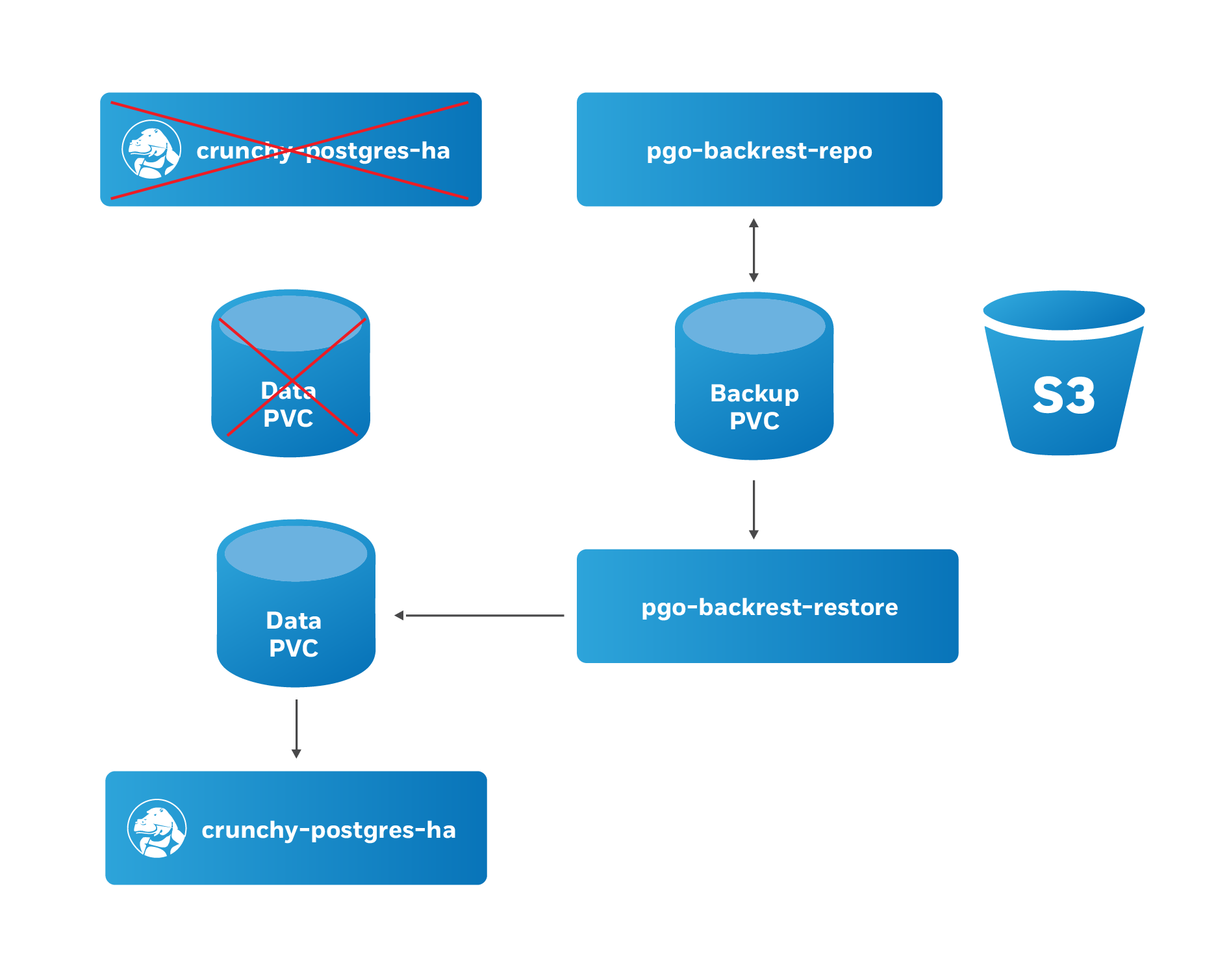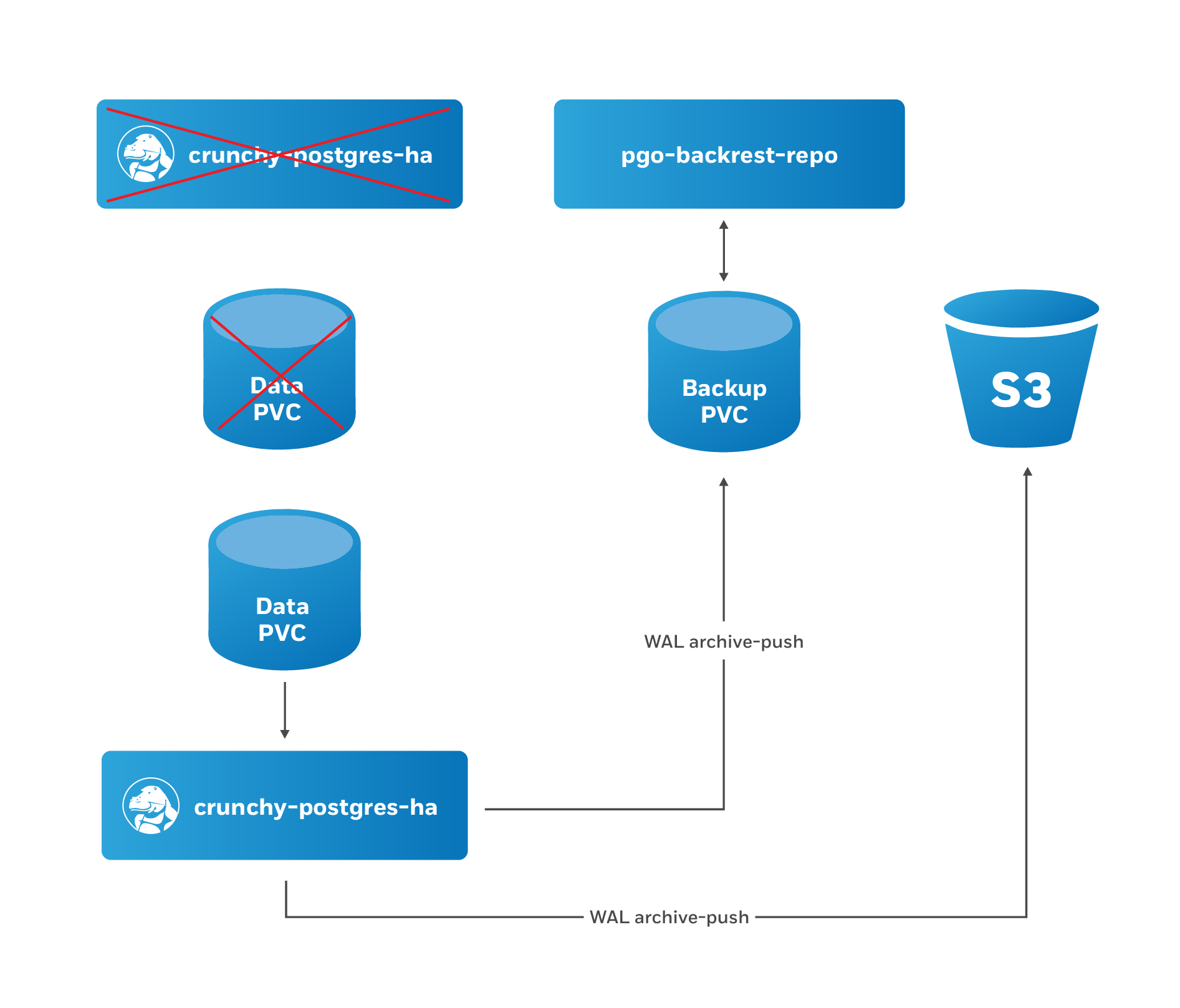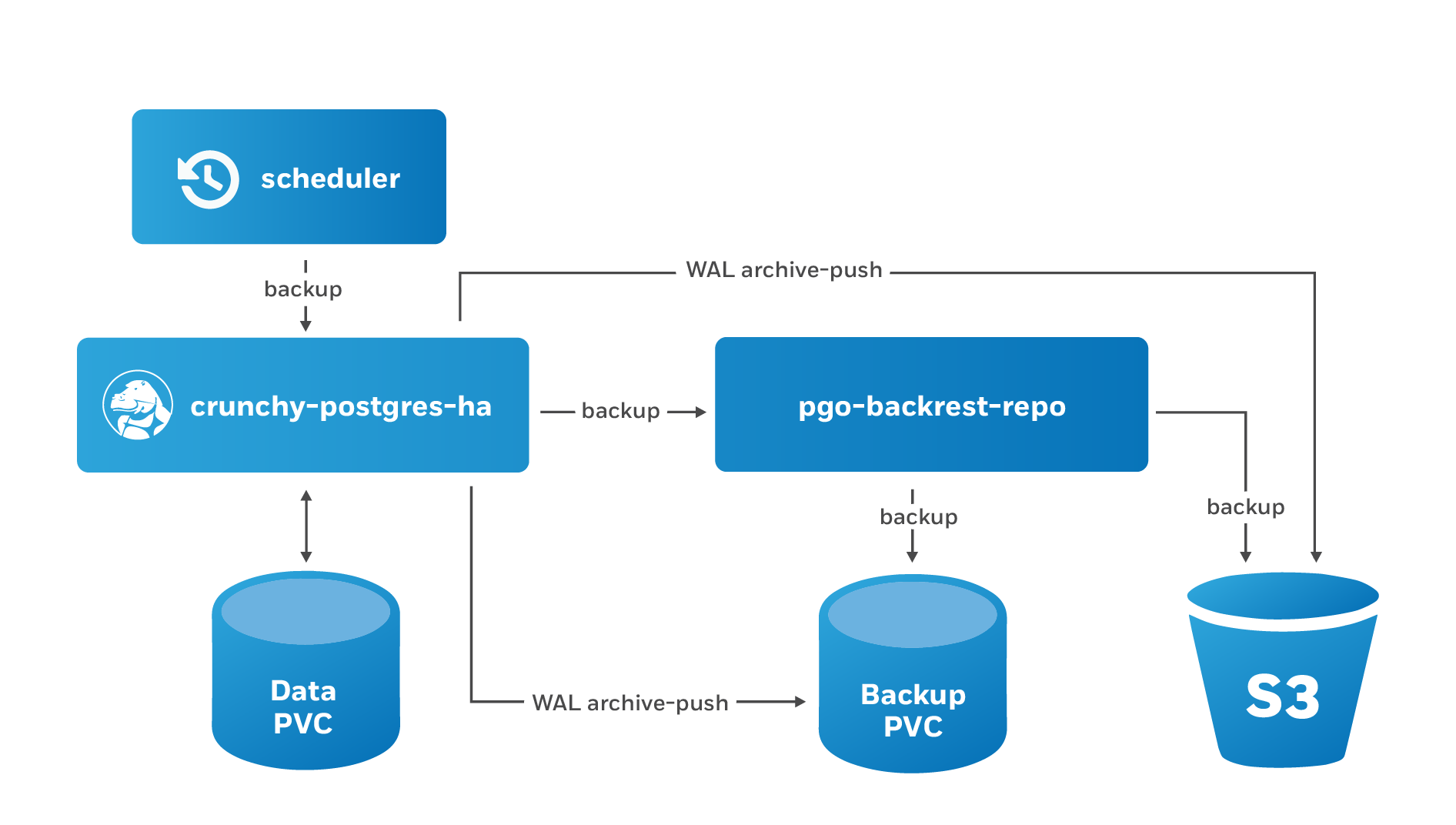Disaster Recovery
When using the PostgreSQL Operator, the answer to the question “do you take backups of your database” is automatically “yes!”
The PostgreSQL Operator uses the open source pgBackRest backup and restore utility that is designed for working with databases that are many terabytes in size. As described in the Provisioning section, pgBackRest is enabled by default as it permits the PostgreSQL Operator to automate some advanced as well as convenient behaviors, including:
- Efficient provisioning of new replicas that are added to the PostgreSQL cluster
- Preventing replicas from falling out of sync from the PostgreSQL primary by allowing them to replay old WAL logs
- Allowing failed primaries to automatically and efficiently heal using the “delta restore” feature
- Serving as the basis for the cluster cloning feature
- …and of course, allowing for one to take full, differential, and incremental backpus and perform full and point-in-time restores

The PostgreSQL Operator leverages a pgBackRest repository to facilitate the usage of the pgBackRest features in a PostgreSQL cluster. When a new PostgreSQL cluster is created, it simultaneously creates a pgBackRest repository as described in the Provisioning section.
At PostgreSQL cluster creation time, you can specify a specific Storage Class for the pgBackRest repository. Additionally, you can also specify the type of pgBackRest repository that can be used, including:
local: Uses the storage that is provided by the Kubernetes cluster’s Storage Class that you selects3: Use Amazon S3 or an object storage system that uses the S3 protocollocal,s3: Use both the storage that is provided by the Kubernetes cluster’s Storage Class that you select AND Amazon S3 (or equivalent object storage system that uses the S3 protocol)
The pgBackRest repository consists of the following Kubernetes objects:
- A Deployment
- A Secret that contains information that is specific to the PostgreSQL cluster that it is deployed with (e.g. SSH keys, AWS S3 keys, etc.)
- A Service
The PostgreSQL primary is automatically configured to use the
pgbackrest archive-push and push the write-ahead log (WAL) archives to the
correct repository.
Backups
Backups can be taken with the pgo backup command
The PostgreSQL Operator supports three types of pgBackRest backups:
- Full (
full): A full backup of all the contents of the PostgreSQL cluster - Differential (
diff): A backup of only the files that have changed since the last full backup - Incremental (
incr): A backup of only the files that have changed since the last full or differential backup
By default, pgo backup will attempt to take an incremental (incr) backup
unless otherwise specified.
For example, to specify a full backup:
pgo backup hacluster --backup-opts="--type=full"The PostgreSQL Operator also supports setting pgBackRest retention policies as well for backups. For example, to take a full backup and to specify to only keep the last 7 backups:
pgo backup hacluster --backup-opts="--type=full --repo1-retention-full=7"Restores
The PostgreSQL Operator supports the ability to perform a full restore on a
PostgreSQL cluster as well as a point-in-time-recovery using the pgo restore
command. Note that both of these options are destructive to the existing
PostgreSQL cluster; to “restore” the PostgreSQL cluster to a new deployment,
please see the Clone section.
The pgo restore command lets you specify the point at which you want to
restore your database using the --pitr-target flag with the pgo restore
command.
NOTE: Ensure you are backing up your PostgreSQL cluster regularly, as this will help expedite your restore times. The next section will cover scheduling regular backups.
When the PostgreSQL Operator issues a restore, the following actions are taken on the cluster:
- The PostgreSQL Operator disables the “autofail” mechanism so that no failovers will occur during the restore.
- Any replicas that may be associated with the PostgreSQL cluster are destroyed
- A new Persistent Volume Claim (PVC) is allocated using the specifications
provided for the primary instance. This may have been set with the
--storage-classflag when the cluster was originally created - A Kubernetes Job is created that will perform a pgBackRest restore operation
to the newly allocated PVC. This is facilitated by the
pgo-backrest-restorecontainer image.

- When restore Job successfully completes, a new Deployment for the PostgreSQL cluster primary instance is created. A recovery is then issued to the specified point-in-time, or if it is a full recovery, up to the point of the latest WAL archive in the repository.
- Once the PostgreSQL primary instance is available, the PostgreSQL Operator will take a new, full backup of the cluster.

At this point, the PostgreSQL cluster has been restored. However, you will need to re-enable autofail if you would like your PostgreSQL cluster to be highly-available. You can re-enable autofail with this command:
pgo update cluster hacluster --autofail=trueScheduling Backups
Any effective disaster recovery strategy includes having regularly scheduled backups. The PostgreSQL Operator enables this through its scheduling sidecar that is deployed alongside the Operator.
The PostgreSQL Operator Scheduler is essentially a cron server that will run jobs that it is specified. Schedule commands use the cron syntax to set up scheduled tasks.

For example, to schedule a full backup once a day at 1am, the following command can be used:
pgo create schedule hacluster --schedule="0 1 * * *" \
--schedule-type=pgbackrest --pgbackrest-backup-type=fullTo schedule an incremental backup once every 3 hours:
pgo create schedule hacluster --schedule="0 */3 * * *" \
--schedule-type=pgbackrest --pgbackrest-backup-type=incrSetting Backup Retention Policies
Unless specified, pgBackRest will keep an unlimited number of backups. As part
of your regularly scheduled backups, it is encouraged for you to set a retention
policy. This can be accomplished using the --repo1-retention-full for full
backups and --repo1-retention-diff for differential backups via the
--schedule-opts parameter.
For example, using the above example of taking a nightly full backup, you can specify a policy of retaining 21 backups using the following command:
pgo create schedule hacluster --schedule="0 1 * * *" \
--schedule-type=pgbackrest --pgbackrest-backup-type=full \
--schedule-opts="--repo1-retention-full=21"Schedule Expression Format
Schedules are expressed using the following rules, which should be familiar to users of cron:
Field name | Mandatory? | Allowed values | Allowed special characters
---------- | ---------- | -------------- | --------------------------
Seconds | Yes | 0-59 | * / , -
Minutes | Yes | 0-59 | * / , -
Hours | Yes | 0-23 | * / , -
Day of month | Yes | 1-31 | * / , - ?
Month | Yes | 1-12 or JAN-DEC | * / , -
Day of week | Yes | 0-6 or SUN-SAT | * / , - ?
Using S3
The PostgreSQL Operator integration with pgBackRest allows it to use the AWS S3 object storage system, as well as other object storage systems that implement the S3 protocol.
In order to enable S3 storage, it is helpful to provide some of the S3
information prior to deploying the PostgreSQL Operator, or updating the
pgo-config ConfigMap and restarting the PostgreSQL Operator pod.
First, you will need to add the proper S3 bucket name, AWS S3 endpoint and
the AWS S3 region to the Cluster section of the pgo.yaml
configuration file:
Cluster:
BackrestS3Bucket: my-postgresql-backups-example
BackrestS3Endpoint: s3.amazonaws.com
BackrestS3Region: us-east-1These values can also be set on a per-cluster basis with the
pgo create cluster command, i.e.:
--pgbackrest-s3-bucket- specifics the AWS S3 bucket that should be utilized--pgbackrest-s3-endpointspecifies the S3 endpoint that should be utilized--pgbackrest-s3-key- specifies the AWS S3 key that should be utilized--pgbackrest-s3-key-secret- specifies the AWS S3 key secret that should be utilized--pgbackrest-s3-region- specifies the AWS S3 region that should be utilized
Sensitive information, such as the values of the AWS S3 keys and secrets, are stored in Kubernetes Secrets and are securely mounted to the PostgreSQL clusters.
To enable a PostgreSQL cluster to use S3, the --pgbackrest-storage-type on the
pgo create cluster command needs to be set to s3 or local,s3.
Once configured, the pgo backup and pgo restore commands will work with S3
similarly to the above!